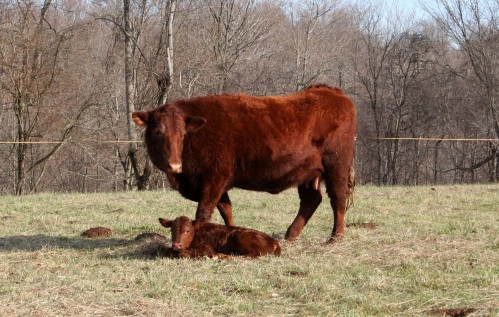As another farmer-blogger put it recently, if you haven’t seen me here much, it’s because I’m busy beyond belief, spending most of my free hours running as fast as I can to stay ahead of Spring. Indiana Jones racing madly down the cave tunnel just a hair’s breadth ahead of the rolling stone ball – that’s kind of what it feels like.
No sooner had I pulled taps and stacked sap buckets, then the calves started coming. Yes, I got the cow herd moved to a dormant grass paddock first, as I had outlined in my transition plan. Thank goodness! And so far, there are three healthy bull calves scampering around their moms and aunts, lending a definite air of Spring freshness to the farm.
Arrivals began the day before St. Patrick’s Day. Counting back on a gestation calendar, that means these three cows were bred in early June. That was long before I arrived on the scene, and who knows what condition they were in – obviously good enough to cycle and conceive. The great mystery is how Bruce the (nearly) infertile bull and his unknown-aged son out of god knows which cow, were able to breed more than three cows in this motley herd.
I say more than three, because there at least two others “bagging up” and showing other signs of impending parturition.
I should have gotten the vet out to preg check them in the fall. Next year I definitely will, but I didn’t really count on too much fertility going on with this bunch this year, between the poor condition of both the cows and bulls when I found them, and the extreme heat. I’d separated them into two herds as soon as I turned them out on my pastures, to allow the girls to recondition, but June and July breeding activity was not in my control. (I will aim to breed later, for calving on green, growing grass.) But it must have happened, because I got calves.
No complaints here, though. All three births were unassisted, wee-hour events in fairly good weather on good clean pasture. All three moms are taking good care of their kids. There’s some udder conformation issues with one, and a late-gestation prolapse occurred with another, so I am not sure if all of the new momma’s are keepers. We’ll let them raise their calves and see how they do. But these three boy calves represent a marketable inventory of grass-fed beef in 2015, if I’m able to raise them to adulthood in good health and with steady growth.
After many years of planning, learning, and waiting, we’re in the cattle business, raising a calf crop, at last.




